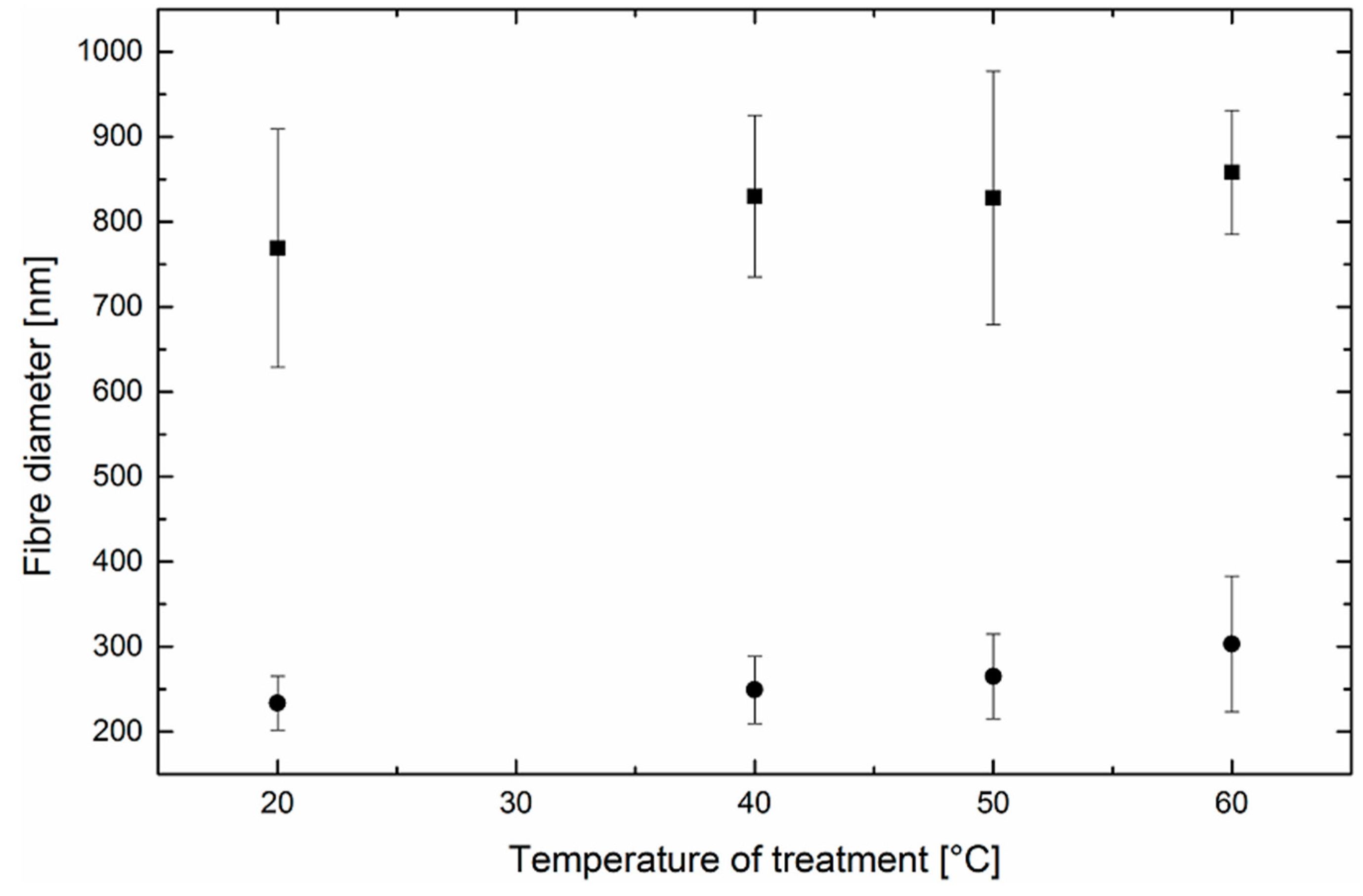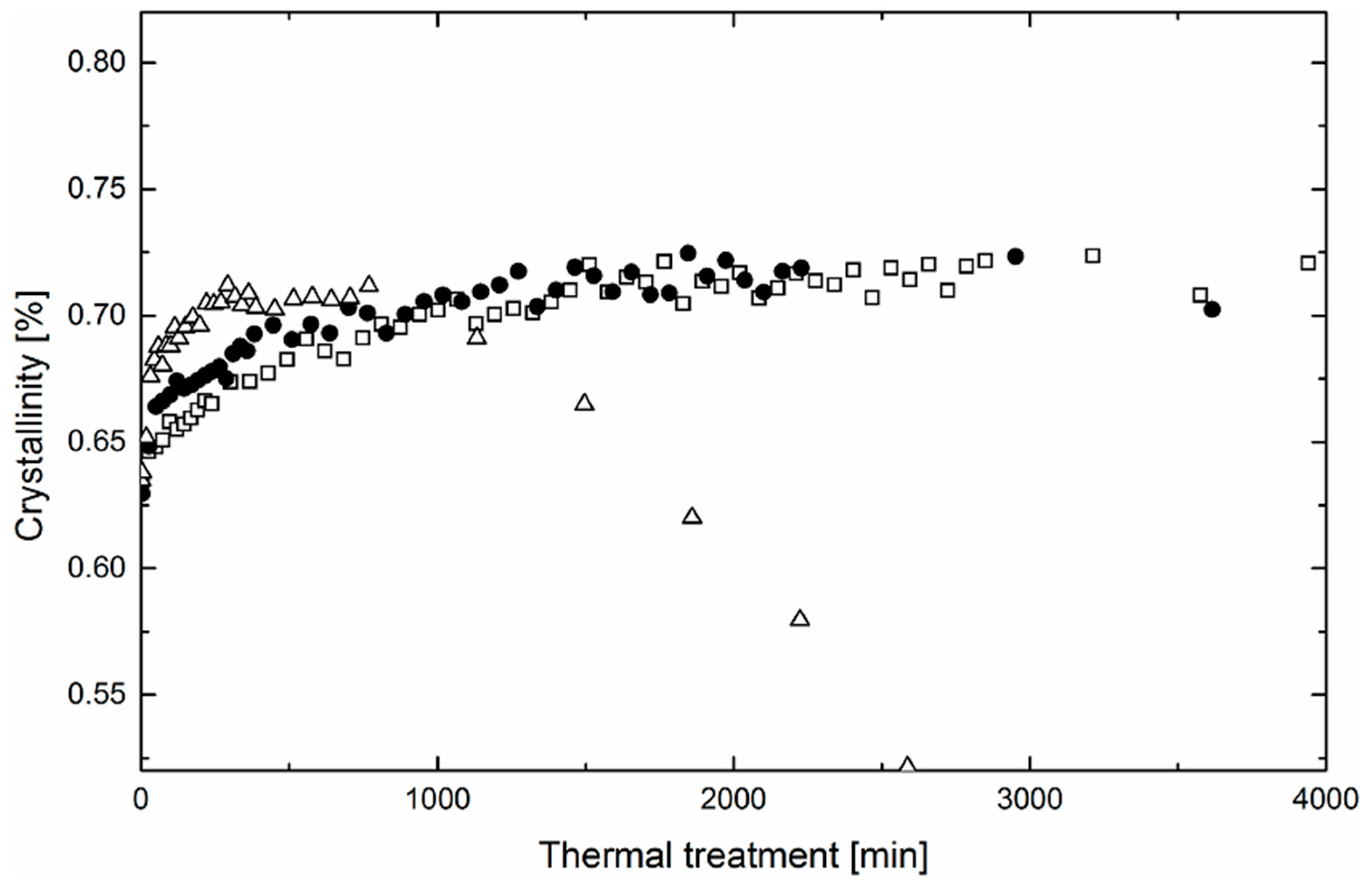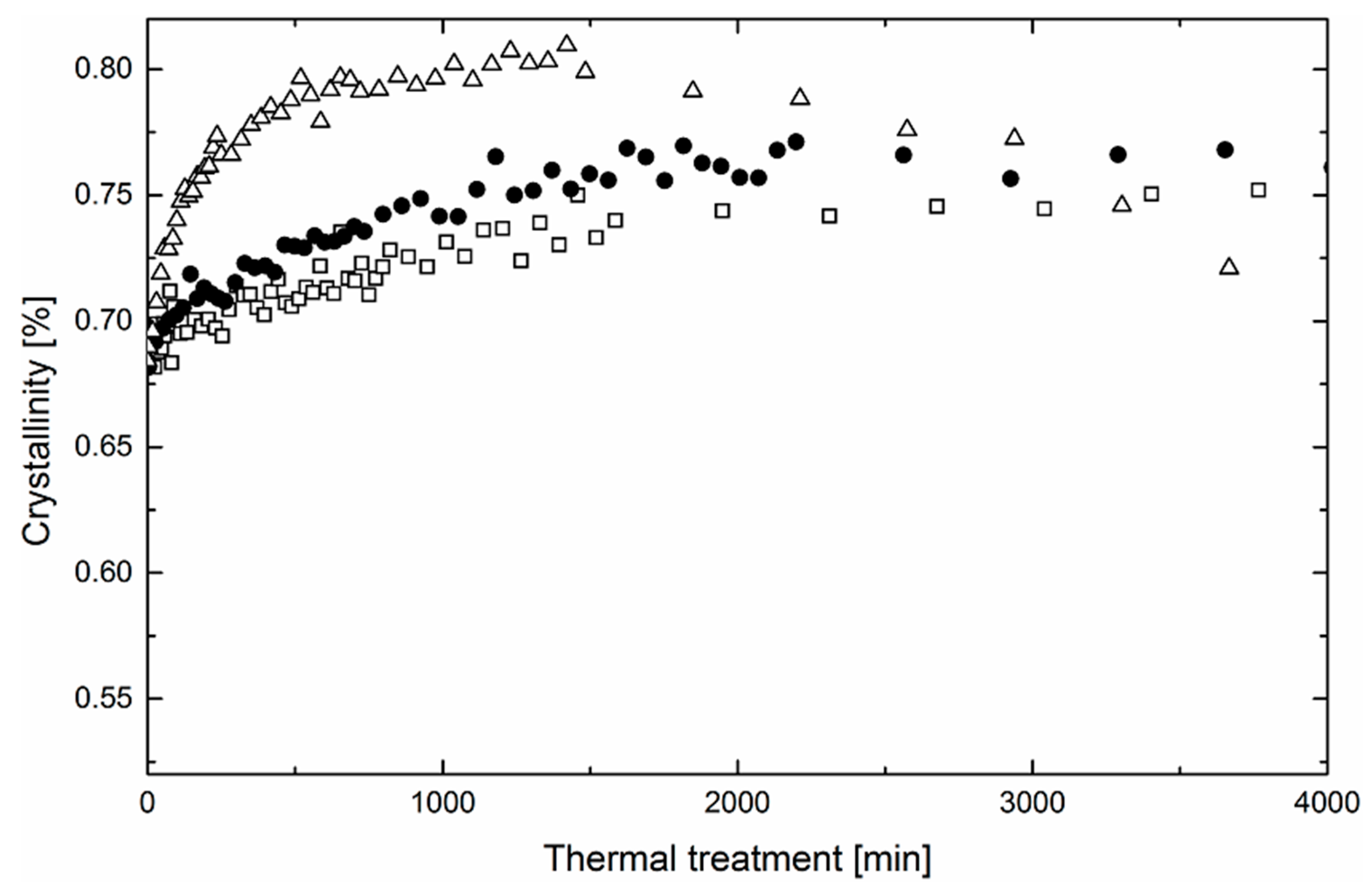Effect of Thermal Treatment on Crystallinity of Poly(ethylene oxide) Electrospun Fibers
Abstract
:1. Introduction
2. Materials and Methods
2.1. Materials
2.2. Characterization of the Solution
2.3. Electrospinning
2.4. Thermal Treatment of Nanofibrous Web
2.5. Characterization of Nanofibrous Web
3. Results and Discussion
4. Conclusions
Author Contributions
Funding
Acknowledgments
Conflicts of Interest
References
- Gazzano, M.; Gualandi, C.; Zucchelli, A.; Sui, T.; Korsunsky, A.M.; Reinhard, C.; Focarete, M.L. Structure-morphology correlation in electrospun fibers of semicrystalline polymers by simultaneous synchrotron saxs-waxd. Polymer 2015, 63, 154–163. [Google Scholar] [CrossRef]
- Pang, L.; Ming, J.; Pan, F.; Ning, X. Fabrication of Silk Fibroin Fluorescent Nanofibers via Electrospinning. Polymers 2019, 11, 986. [Google Scholar] [CrossRef] [PubMed]
- Liu, W.; Zhang, J.; Liu, H. Conductive Bicomponent Fibers Containing Polyaniline Produced via Side-by-Side Electrospinning. Polymers 2019, 11, 954. [Google Scholar] [CrossRef] [PubMed]
- Polonio-Alcalá, E.; Rabionet, M.; Gallardo, X.; Angelats, D.; Ciurana, J.; Ruiz-Martínez, S.; Puig, T. PLA Electrospun Scaffolds for Three-Dimensional Triple-Negative Breast Cancer Cell Culture. Polymers 2019, 11, 916. [Google Scholar] [CrossRef] [PubMed]
- Deitzel, J.M.; Kleinmeyer, J.; Harris, D.; Beck Tan, N.C. The effect of processing variables on the morphology of electrospun nanofibers and textiles. Polymer 2001, 42, 261–272. [Google Scholar] [CrossRef]
- Jacobs, V.; Anandjiwala, R.D.; Maaza, M. The influence of electrospinning parameters on the structural morphology and diameter of electrospun nanofibers. J. Appl. Polym. Sci. 2010, 115, 3130–3136. [Google Scholar] [CrossRef]
- Son, W.K.; Youk, J.H.; Lee, T.S.; Park, W.H. The effects of solution properties and polyelectrolyte on electrospinning of ultrafine poly (ethylene oxide) fibers. Polymer 2004, 45, 2959–2966. [Google Scholar] [CrossRef]
- Shenoy, S.L.; Bates, W.D.; Frisch, H.L.; Wnek, G.E. Role of chain entanglements on fiber formation during electrospinning of polymer solutions: Good solvent, non-specific polymer–polymer interaction limit. Polymer 2005, 46, 3372–3384. [Google Scholar] [CrossRef]
- Grkovic, M.; Stojanovic, D.B.; Pavlovic, V.B.; Rajilic-Stojanovic, M.; Bjelovic, M.; Uskokovic, P.S. Improvement of mechanical properties and antibacterial activity of crosslinked electrospun chitosan/poly (ethylene oxide) nanofibers. Compos. Part B Eng. 2017, 121, 58–67. [Google Scholar] [CrossRef]
- Esmaeli, A.; Haseli, M. Electrospinning of thermoplastic carboxymethyl cellulose/poly (ethylene oxide) nanofibers for use in drug-release systems. Mater. Sci. Eng. C Mater. Biol. Appl. 2017, 77, 1117–1127. [Google Scholar] [CrossRef]
- Baniasadi, M.; Xu, Z.; Cai, J.; Daryadel, S.; Quevedo-Lopez, M.; Naraghi, M.; Minary-Jolandan, M. Correlation of annealing temperature, morphology and electro-mechanical properties of electrospun piezoelectric nanofibers. Polymer 2017, 127, 192–202. [Google Scholar] [CrossRef]
- Kancheva, M.; Toncheva, A.; Manolova, N.; Rashkov, I. Enhancing the mechanical properties of electrospun polyester mats by heat treatment. Express Polym. Letters 2015, 9, 49–65. [Google Scholar] [CrossRef] [Green Version]
- Wahab, J.A.; Lee, H.; Wei, K.; Nagaishi, T.; Khatri, Z.; Behera, B.K.; Kim, K.B.; Kim, I.S. Post-electrospinning thermal treatments on poly(4-methyl-1-pentene) nanofiber membranes for improved mechanical properties. Polym. Bull. 2017, 74, 5221–5230. [Google Scholar] [CrossRef]
- Bao, J.; Clarke, L.I.; Gorga, R.E. Effect of constrained annealing on the mechanical properties of electrospun poly(ethylene oxide) webs containing multiwalled carbon nanotubes. J. Polym. Sci., Part. B Polym. Phys. 2016, 54, 787–796. [Google Scholar] [CrossRef]
- Oliveira, J.E.; Mattoso, L.H.C.; Orts, W.J.; Medeiros, E.S. Structural and morphological characterization of micro and nanofibers produced by electrospinning and solution blow spinning: A comparative study. Adv. Mater. Sci. Eng 2013, 2013, 1–14. [Google Scholar] [CrossRef]
- Deitzel, J.M.; Kleinmeyer, J.D.; Hirvonen, J.K.; Tan, N.C.B. Controlled deposition of electrospun poly(ethylene oxide) fibers. Polymer 2001, 42, 8163–8170. [Google Scholar] [CrossRef]
- Richard-Lacroix, M.; Pellerin, C. Molecular orientation in electrospun fibers: From mats to single fibers. Macromolecules 2013, 46, 9473–9493. [Google Scholar] [CrossRef]
- Tripatanasuwan, S.; Zhong, Z.; Reneker, D.H. Effect of evaporation and solidification of the charged jet in electrospinning of poly (ethylene oxide) aqueous solution. Polymer 2007, 48, 5742–5746. [Google Scholar] [CrossRef]
- Lee, S.J.; Oh, S.H.; Liu, J.; Soker, S.; Atala, A.; Yoo, J.J. The use of thermal treatments to enhance the mechanical properties of electrospun poly(epsilon-caprolactone) scaffolds. Biomaterials 2008, 29, 1422–1430. [Google Scholar] [CrossRef]
- De Sainte Claire, P. Degradation of peo in the solid state: A theoretical kinetic model. Macromolecules 2009, 42, 3469–3482. [Google Scholar] [CrossRef]
- Morlat, S.; Gardette, J.L. Phototransformation of water-soluble polymers. I: Photo- and thermooxidation of poly (ethylene oxide) in solid state. Polymer 2001, 42, 6071–6079. [Google Scholar] [CrossRef]
- Peer, P.; Filip, P. Nanofibrous web quality in dependence on the preparation of poly (ethylene oxide) aqueous solutions. J. Text. I. 2017, 108, 2021–2026. [Google Scholar] [CrossRef]
- Hansen, C. Hansen Solubility Parameters: A User’s Handbook, 2nd ed.; CRC Press: Boca Raton, FL, USA, 2007. [Google Scholar]
- Frank, F. Water: A Comprehensive Treatise 4; Plenum Press: New York, NY, USA, 1975. [Google Scholar]
- Obadal, M.; Čermák, R.; Raab, M.; Verney, V.; Commereuc, S.; Fraïsse, F. Structure evolution of α- and β-polypropylenes upon uv irradiation: A multiscale comparison. Polym. Degrad. Stabil. 2005, 88, 532–539. [Google Scholar] [CrossRef]
- Wang, W.; Barber, A.H. Diameter-dependent melting behaviour in electrospun polymer fibres. Nanotechnology 2010, 21, 225701. [Google Scholar] [CrossRef] [PubMed]
- Monar, K.; Habenschuss, A. Modeling the principal amorphous halo in quiescent melts of polyethylene and ethylene copolymers using wide-angle x-ray scattering and its implications. J. Polym. Sci. Pol. Phys. 1999, 37, 3401–3410. [Google Scholar] [CrossRef]
- Rabiej, S. Waxs investigations of the amorphous phase structure in linear polyethylene and ethylene-1-octene homogeneous copolymers. Fibres Text. East. Eur 2005, 13, 30–34. [Google Scholar]
- Zhang, Z.Z.; Sui, G.; Bi, H.T.; Yang, X.P. Radiation-crosslinked nanofiber membranes with well-designed core-shell structure for high performance of gel polymer electrolytes. J. Membr. Sci. 2015, 492, 77–87. [Google Scholar] [CrossRef]
- Guven, O. Effects of solvents on the crystallization of dilute poly (ethylene oxide) solutions. Colloid Polym. Sci. 1982, 260, 647–651. [Google Scholar] [CrossRef]






| Solvent | Viscosity [mPa.s] at 25 °C | Relative Permittivity | Specific Conductivity [S/m] | Surface Tension [mN/m] | Vapor Pressure [mm.Hg] |
|---|---|---|---|---|---|
| Water | 0.89 | 80.1 | 5.5 × 10−6 | 72 | 175 |
| Methanol | 0.59 | 32.7 | 1.5 × 10−7 | 22.1 | 100 |
| Solvent | Shear Viscosity [Pa.s] | Phase Angle [°] | Mean Diameter [nm] | Standard Deviation [nm] |
|---|---|---|---|---|
| Water | 5.4 | 57.6 | 200 | 30 |
| Methanol | 1.3 | 61.1 | 768 | 140 |
© 2019 by the authors. Licensee MDPI, Basel, Switzerland. This article is an open access article distributed under the terms and conditions of the Creative Commons Attribution (CC BY) license (http://creativecommons.org/licenses/by/4.0/).
Share and Cite
Polaskova, M.; Peer, P.; Cermak, R.; Ponizil, P. Effect of Thermal Treatment on Crystallinity of Poly(ethylene oxide) Electrospun Fibers. Polymers 2019, 11, 1384. https://doi.org/10.3390/polym11091384
Polaskova M, Peer P, Cermak R, Ponizil P. Effect of Thermal Treatment on Crystallinity of Poly(ethylene oxide) Electrospun Fibers. Polymers. 2019; 11(9):1384. https://doi.org/10.3390/polym11091384
Chicago/Turabian StylePolaskova, Martina, Petra Peer, Roman Cermak, and Petr Ponizil. 2019. "Effect of Thermal Treatment on Crystallinity of Poly(ethylene oxide) Electrospun Fibers" Polymers 11, no. 9: 1384. https://doi.org/10.3390/polym11091384




